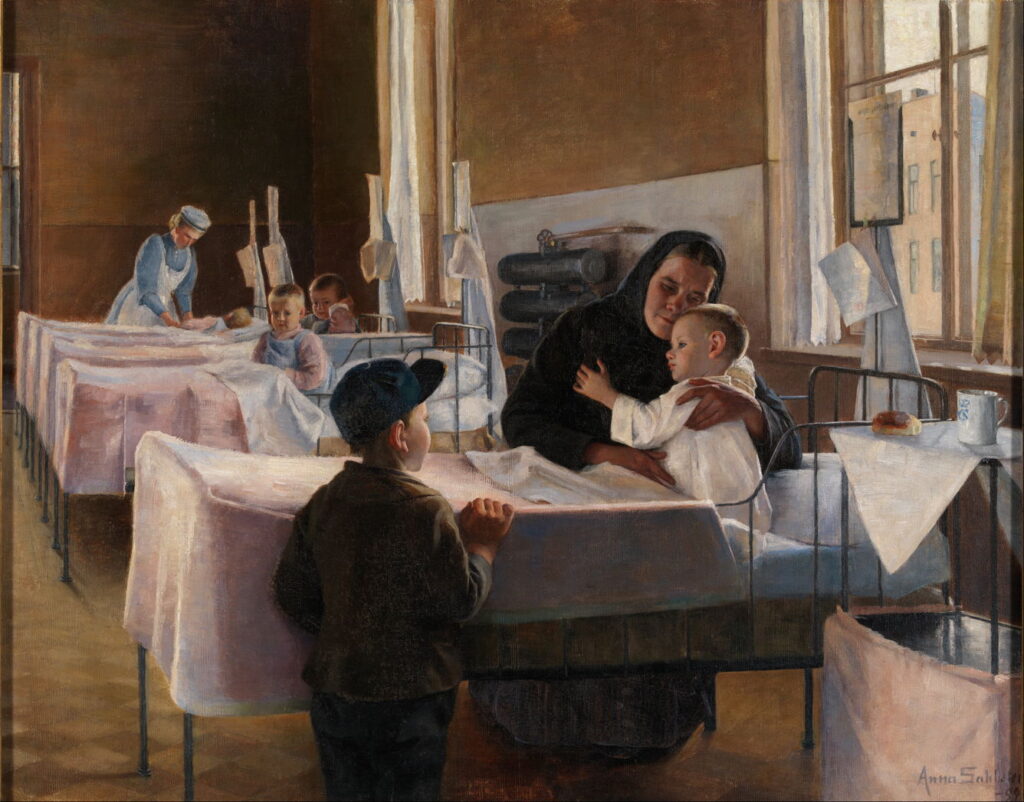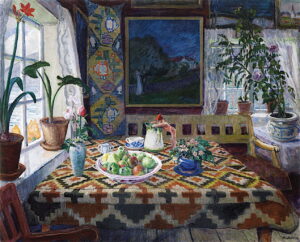Interiors by Design: Hospital wards

You can’t get through life without seeing a hospital ward interior, and for most of us it’s now where we both start and end our lives. Over the centuries, hospital wards have changed from being mere dormitories to facilities for nursing and medical care of the sick. This article shows in paintings how and when those changes occurred.
Although medicine was still in its infancy at the end of the sixteenth century, it was then that hospital wards first became recognisable in modern terms.
Adam Elsheimer (1578–1610), Saint Elizabeth of Hungary Bringing Food for the Inmates of a Hospital (c 1598), oil on copper, 27.8 x 20 cm, The Wellcome Collection, London. Courtesy of and © Wellcome Trust, via Wikimedia Commons.
Adam Elsheimer’s Saint Elizabeth of Hungary Bringing Food for the Inmates of a Hospital from about 1598 shows a ward run by a religious order or similar foundation. Above each bed is a religious painting, and watching over them all is a statue of the Virgin Mary holding the infant Christ. Saint Elizabeth works with her halo visible, feeding the man in the bed nearest the viewer.
Johannes Beerblock (1739–1806), Wards of the Hospital of Saint John (1778), oil on canvas, 153 × 82 cm, Museum Saint John’ Hospital, Bruges, Belgium. Wikimedia Commons.
With the Age of Enlightenment came the first major voluntary hospitals, funded by benefactors, charities, and public subscription. Johannes Beerblock’s painting shows the modern Wards of the Hospital of Saint John in the city of Bruges in 1778. Each bed was, in effect, its own private cubicle. There were trained medical staff, but nurses were still compassionate carers rather than professionals.
In the centre, middle distance, a group of four elegantly dressed physicians are doing the rounds of their patients. The main caring staff appear to be from a religious order, and wear its elaborate black-and-white uniforms. They are serving food, reading to comfort the sick and dying, and at the left are assisting a priest, perhaps in administering the last rites. Lay staff are cleaning and servicing the needs of patients.
William Simpson (1823–1899), One of the Wards in the Hospital at Scutari (Turkey) (1856), lithograph by E. Walker, published by Paul and Dominic Colnaghi, restored by Adam Cuerden, The Wellcome Collection, London. Courtesy of and © Wellcome Trust, via Wikimedia Commons.
One of the most important revolutions in healthcare was associated with the work of Florence Nightingale during the Crimean War. Although she is now a controversial figure, William Simpson’s illustration of One of the Wards in the Hospital at Scutari (Turkey) from 1856 gives an idea of the change that started in the middle of the nineteenth century. Towards the left is a large cabinet containing glass vessels of medication, and there’s a central stove to provide a little heat through the winter.
Luis Jiménez Aranda (1845-1928), Doctors’ Rounds in the Hospital Ward (1889), oil on canvas, 290 x 445 cm, Museo de Bellas Artes de Sevilla, Seville, Spain. Wikimedia Commons.
The hospital building shown in Luis Jiménez Aranda’s painting of Doctors’ Rounds in the Hospital Ward from 1889 isn’t modern by contemporary standards. A large and august team of physicians, no doubt with their trainees, is examining a patient’s chest during a ward round. The senior physician is bent down with his left ear applied to the back of the patient’s chest. Today, that act of auscultation would be performed using a stethoscope, almost a badge of office for medical practitioners around the world. The stethoscope was still relatively novel in 1889: simple monaural tubes were first used by Laënnec in 1816, but the modern binaural design didn’t evolve until the late 1800s, and an older physician may still have preferred to apply their ear directly to the patient, as shown.
Jean Geoffroy (1853-1924), Visiting Day at the Hospital (1889), oil on canvas, 120 x 95 cm, Musée d’Orsay, Paris. Wikimedia Commons.
Perhaps the first painting of what we’d recognise as a modern hospital, Jean Geoffroy’s Visiting Day at the Hospital from that same year, is all about light, cleanliness, and the clinical. Like other Naturalist paintings of the time, it also fitted in neatly with the Third Republic’s image of modernising, by applying the latest developments of science to the improvement of life, and illness.
Vincent van Gogh (1853–1890), Dormitory in the Hospital in Arles (1889), oil on canvas, 74 x 92 cm, Private collection. Wikimedia Commons.
Van Gogh’s Dormitory in the Hospital in Arles (1889) shows how, despite their improvement, mental hospitals were still a long way behind general hospitals of the day. In the foreground is a stove similar to that of Florence Nightingale’s ward in Scutari, and the carers are members of a religious order rather than specialist mental health nurses.
Anna Sahlstén (1859–1931), Surgery in hospital (c 1893), oil on canvas, dimensions not known, EMMA – Espoon modernin taiteen museo, Espoo, Finland. Wikimedia Commons.
Anna Sahlstén’s Surgery in Hospital from about 1893 shows the dazzling whiteness of the modern hospital, with a smart professional nurse caring for a child patient in the background. On the wall is a large radiator for the hospital’s modern heating system, replacing the traditional stove at last. That’s perhaps just as well, given the winters in Finland, where this was painted.
Nikolay Petrovich Bogdanov-Belsky (1868-1945), At the Hospital (c 1910), further details not known. The Athenaeum.
In one of his loosest and most sketchy works, Nikolay Petrovich Bogdanov-Belsky dazzles with white and light in At the Hospital from about 1910. The nurse is taking a patient’s pulse. This ward’s windows are open wide to the countryside beyond, and there’s a large vase of flowers at the right, presumably for the healing effects of nature.
Douglas Fox Pitt (1864–1922), Indian Army Wounded in Hospital in the Dome, Brighton (1919), oil on canvas, 60.9 x 50.8 cm, The Imperial War Museum, London. Courtesy of the Imperial War Museum, via Wikimedia Commons.
Indian Army Wounded in Hospital in the Dome, Brighton from 1919 is one of Douglas Fox Pitt’s few oil paintings, and shows the Brighton Pavilion in its role as a military hospital with two operating theatres and more than seven hundred beds, making it a unique ward interior. It was unusual for its time in supportingr a wide range of religious, ethnic and dietary needs. However, this painting was made three years after that hospital had closed, following which it had been reopened for the many amputees from the war, providing them with rehabilitation and training. That too closed in the summer of 1920.




